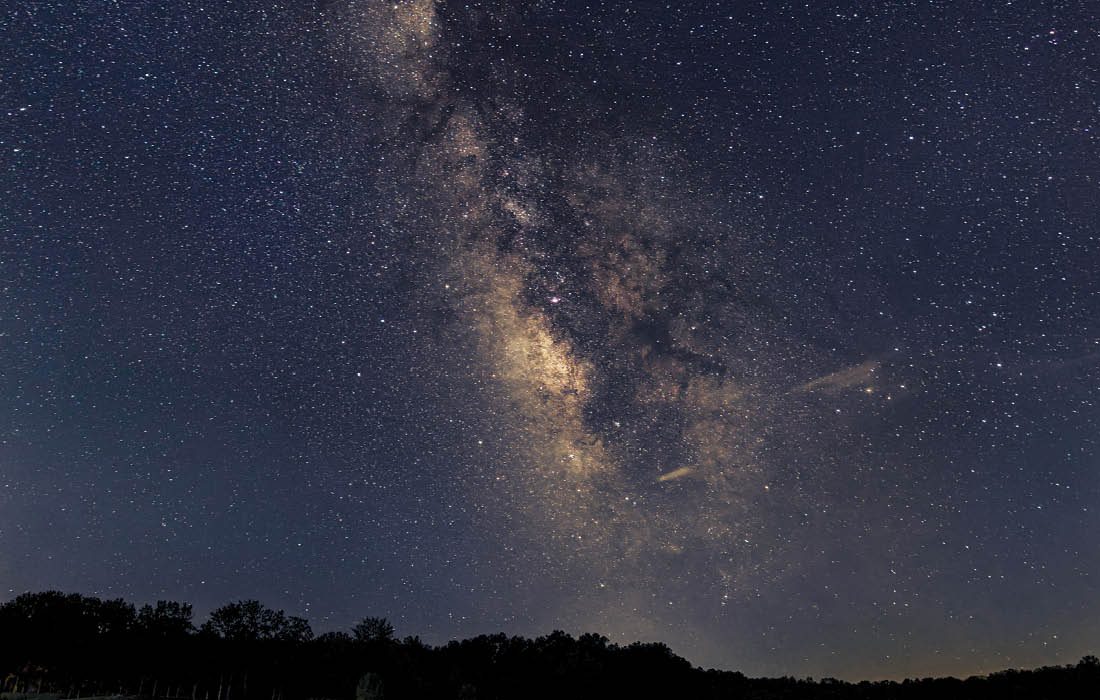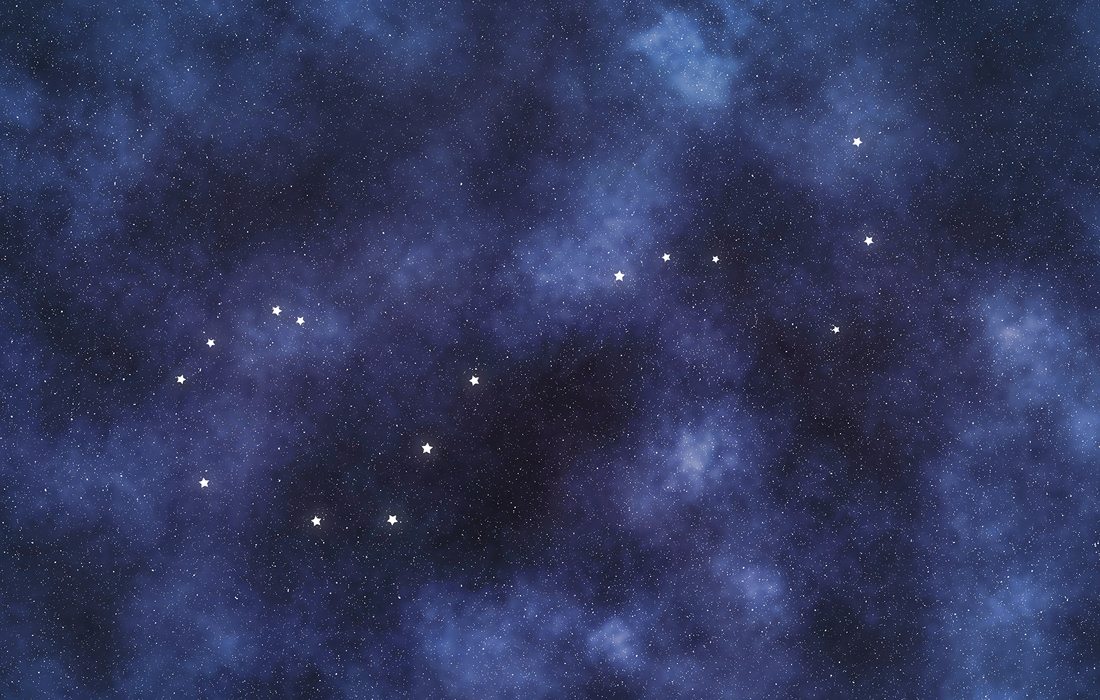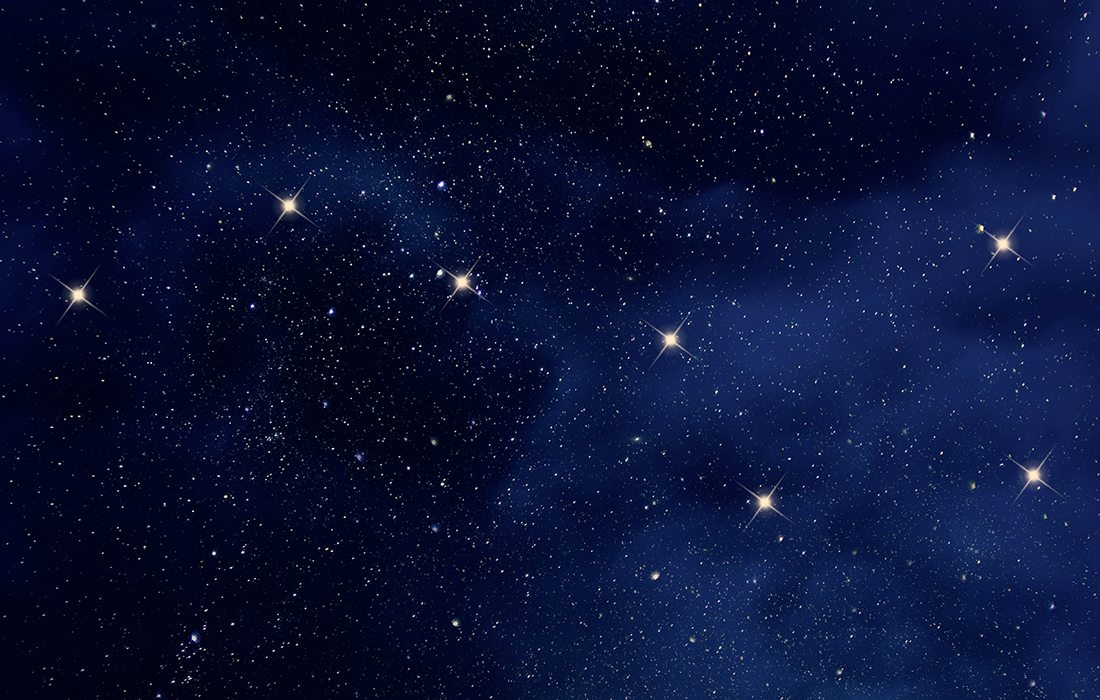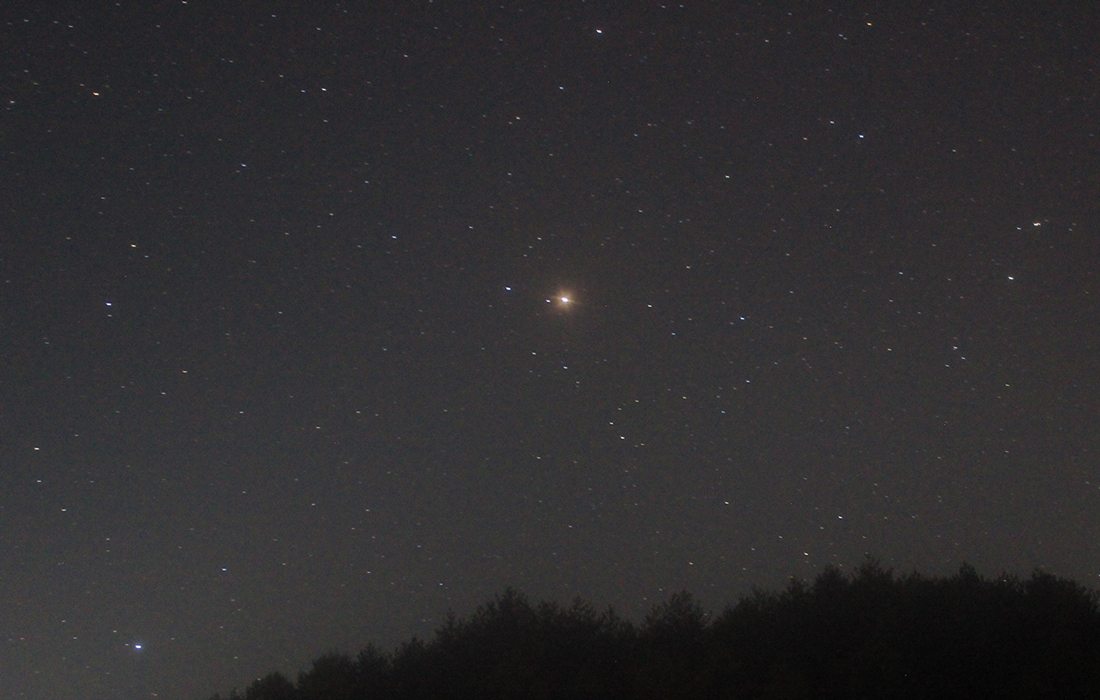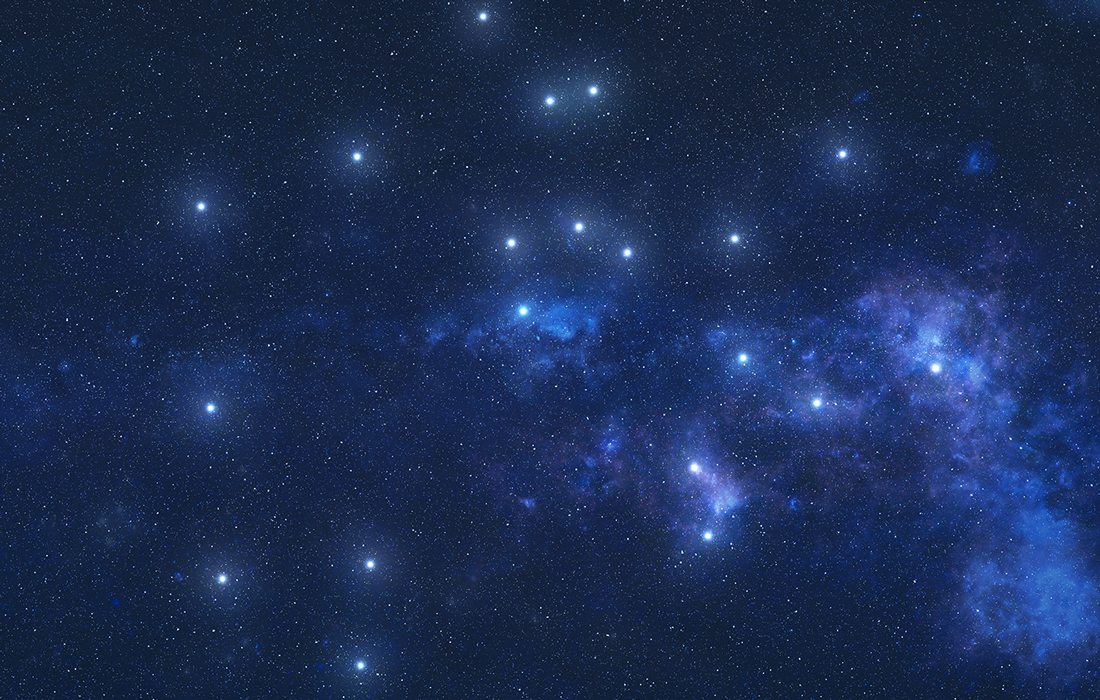Outdoors
Where to Stargaze in Southwest Missouri
Dark sky tourism is on the rise in the Ozarks—along with outreach and advocacy from locals wanting to preserve our starry skies. That’s good news for outdoor enthusiasts and stargazers of all ages.
By Sony Hocklander
Aug 2025

Jump to a Section
As dusk gives way to twilight and growing darkness, stars appear in the clear night sky. First, only the brightest. You can make out the Big Dipper. Then Polaris—the north star—emerges. Soon, eyes adjust to the night—darker than many gathered on the wide open greenspace near Big Spring have experienced.
And there, to the south, at last, the Milky Way and its galactic core become visible. One woman weeps: She’s never seen it before. An excited youngster with his first telescope focuses successfully on a star, enthralled by more than two dozen volunteers sharing their telescopes with the crowd.
DarkSky Missouri’s first festival star party, held last fall at Big Spring Campground on the Current River, left good memories for those who attended. Many in the crowd of roughly 200, including volunteers, organizers and attendees, came from Springfield. This year’s festival returns to Big Spring October 17 and 18, and a similar festival in its fourth year is planned for September 19 and 20 near the Buffalo National River in Arkansas.
Both festivals’ success illustrates growing interest in viewing starry skies in dark places and protecting those skies by reducing light pollution. Ozarkers value the natural outdoors where they hike, float, cycle, fish, camp and more. No wonder that extends to the outdoors at night.
Yearning to experience a truly dark sky with sparkling stars for yourself? Late summer and fall are great seasons to seek celestial wonders away from city lights, whether it’s a rising full moon, easy-to-spot constellations, or astronomical events like the popular Perseids meteor shower in mid-August. Not only that, the Milky Way rises earlier this time of year, so you don’t have to stay up as late to see or photograph it.
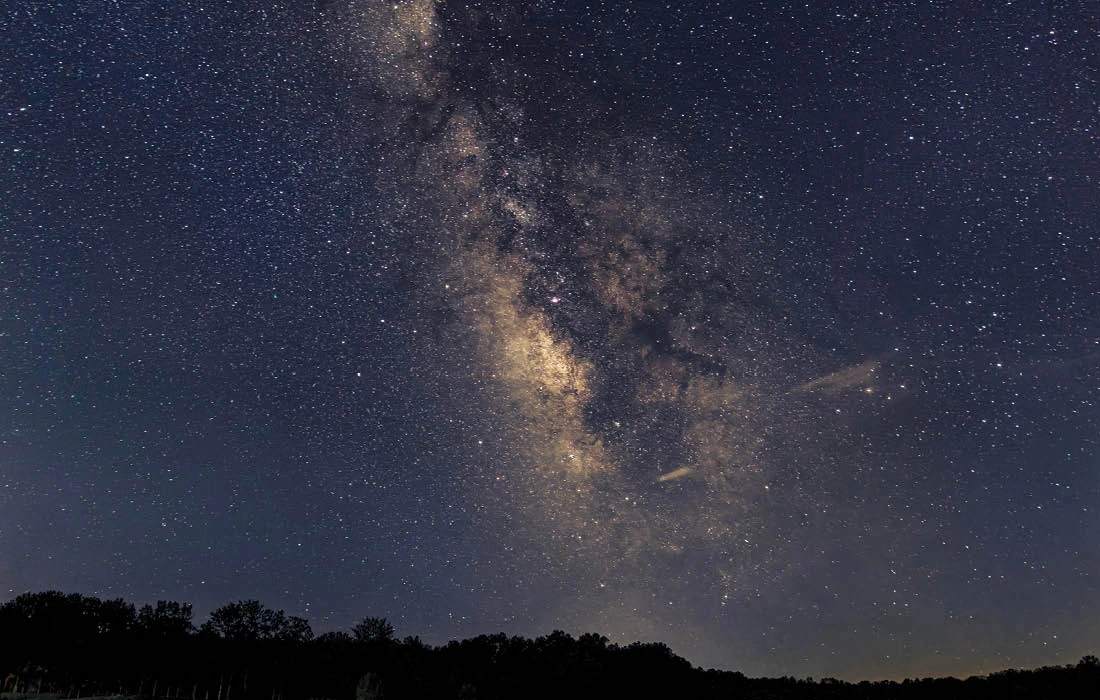
Protecting Dark Skies in the Ozarks
There’s nothing like stargazing under a truly dark night sky, says DarkSky Missouri board member Loring Bullard, a local author, naturalist and former executive director of Watershed Committee of the Ozarks.
“That was always a big part of the experience of going out and camping under the stars in a wilderness somewhere, and really being able to feel like you can reach out and touch those stars,” Bullard says. “It’s such an incredible feeling.” But we can’t take dark skies for granted, he and other advocates say. In fact, dark skies are disappearing as urban development expands. Research in the last decade reveals that more than 99 percent of U.S. residents live in areas with light pollution, and 80 percent can’t see the Milky Way.
For generations, people have used indiscriminate lighting around their properties as a misguided and excessive practice. But a growing movement calls for adopting responsible lighting practices to help reduce city glow that diminishes dark skies for miles.
The concern is not just to save stargazing. Scientists say excess artificial light is disruptive to feeding, mating and growing cycles for plants, insects, birds and animals. Living things—including people—need darkness, says Bullard. “Everything is tuned to that cycle of day and night.”
Cathy Webb of Springfield, who helps plan the Dark Sky Festival, is a board member with Bullard of DarkSky Missouri, a chapter of DarkSky International, the advocacy organization that bestows Dark Sky Place designations for deserving applicants. Webb is also a member of Greater Ozarks Audubon Society. She became interested in dark sky conservation when she learned how light pollution disrupts bird migration.
Reducing light pollution “is even, we’re finding out, important for things like the food system,” says Katherine Auld, an astronomy professor at Northwest Arkansas Community College and board member for Arkansas Natural Sky Association (ANSA), another affiliate of DarkSky International. That’s because pollination happens at night by moths, bats and other living things that come out at dark.
People often don’t know any of that until they attend an astronomy event, whether at a festival, a public viewing at Missouri State University’s Baker Observatory, through the Springfield Astronomical Society or at local and state parks. Those are good ways to connect people to the natural environment, Webb says, “where you can actually see what you’re helping to protect. The night sky evokes emotion. It’s an inviting environment that is full of wonder. People will remember that and they will want to protect it more.”
Nighttime Photography 101
Late summer to early fall is a great time for beginners to try Milky Way photography. That’s because the Milky Way is visible by around 9 or 10 p.m. Hal Mitzenmacher and Brennen Nicole—two Arkansas photographers who have taught beginning classes—share a few basic starting tips.
You’ll need a camera with manual settings, a wide-angle lens (ideally with at least 2.8 aperture), a sturdy tripod, fully charged batteries, and red flashlights and/or head lamp.
It’s best to use a camera but newer phones can capture the Milky Way for social media. Do use a tripod for stability to get a clearer image.
If using a camera—best for this kind of photography—learn to use manual settings at home before getting out in the dark. Practice changing your settings and pressing the shutter without looking. (Bonus: Learn to use a photo planning app like Photopills or Planit Pro, which help in night sky photography.)
Choose a dark area with a wide-open night sky. For the darkest skies, plan for a date near the new moon and go on a cloudless night. If humidity is low – even better.
Bring warm clothes, water, snacks and a chair or blanket.
Upon arrival, let your eyes get used to the dark and look for the Milky Way which, to the unpracticed eye, may look like a streak of wispy clouds. (Don’t worry: Your camera sees it better.)
Put your camera on the tripod and make initial settings. There’s no one right way to start, but try these: ISO: 3200 or go to 6400 if you need more light and your camera handles noise. F-stop: Widest aperture the lens will go (ideally at least 2.8) or one stop down. Shutter: Between 15 and 30 seconds. (Use a longer shutter speed if you need more light but it will likely elongate the stars. It’s better to go with 20 seconds or less if you can.)
Find a star to manually focus on; check that it’s sharp. (This is the hardest part. If you’re not sure how to get proper focus, try setting your lens to infinity, suggests Nicole.)
After taking your first image, zoom in to look and make adjustments.
Once you find success with the sky, look for tutorials to add to your skill and keep practicing. Or sign up for a hands-on workshop. Nicole conducts several a year through her business; Mitzenmacher does them occasionally with camera clubs.
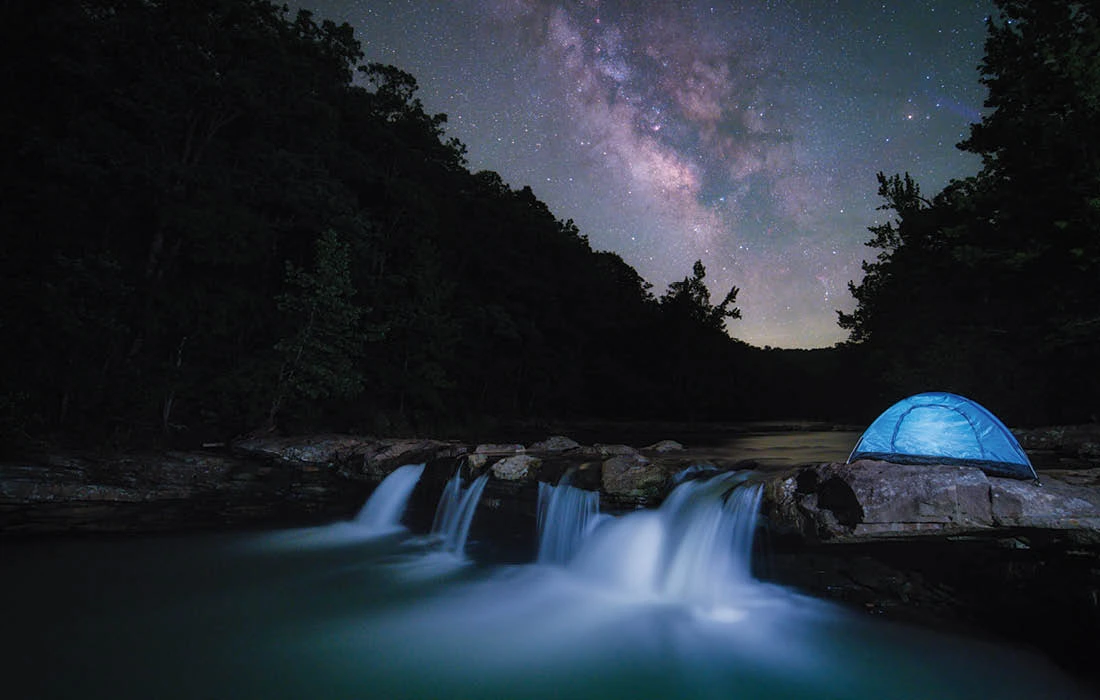
Spreading the Message
Bullard says it will take a culture shift to reduce light pollution, not only in parks and natural spaces, but in urban communities, too. Still, light pollution awareness is growing.
“There’s no question that the awareness is starting to spread,” says Bruce McMath, an amateur astronomer and retired lawyer who chairs ANSA. “It’s got a long way to go, but an increasing, significant part of the population has at least heard of light pollution.”
McMath says DarkSky International promotes the implementation of responsible lighting principles. Those principles include using light only when needed and no more than necessary, for instance, shielding fixtures so light only points down and not at the sky. That also includes using motion detectors and changing lights to warmer color temperatures.
The good news is, “we’ve got communities finally coming around and thinking about lighting ordinances and so forth,” McMath says. One of those is the city of Ozark, which in July 2021, passed a dark sky ordinance to adopt those responsible lighting principles. Spearheaded by Assistant City Administrator Cameron Smith, who worked with DarkSky Missouri and Truman University, it doesn’t apply to individual residences. But the ordinance requires remodeled or new public property development to comply with those principles, so it will become a cumulative effect. “We wanted to get ahead of light pollution the best we could,” Smith says.
The ordinance—the first of its kind for a city in Missouri—is making an impact and has been embraced by the community, Smith says. Given local interest in the outdoors and natural resources, it aligns with community goals and values. Springfield is also making changes to lighting policies as part of its long-range plan. Based on public feedback, protecting the night sky was included with Forward SGF, the city’s comprehensive plan and blueprint for its future goals.
Steps have already begun, according to Justin Crighton, assistant director of Planning & Development. “The updated Land Development Code incorporates the dark sky principles into the Landscape and Site Design Article, with the goal being to reduce light pollution overall,” he shares. The code, effective in early 2026, incorporates corrected color lighting with height restrictions and shielding requirements that limit light spillage as projects are developed going forward.
These progressive efforts bode well for stargazers and people who care about the Ozarks outdoors.
How To Find Dark Skies
Area experts shared their favorite dark sky viewing spots and we found excellent location resources at darkskymissouri.org and darkskyarkansas.org. The night sky is best viewed in open space away from urban communities and city glow. Stick to public land that allows nighttime occupation, or private land with permission. State parks with camping/lodging are good options. Or book a rental in a dark sky area (ANSA includes a list of dark sky-friendly rentals at darkskyarkansas.org). Also try public Army Corps of Engineers marinas and boat docks in dark locations.
To find areas on your own, review a light pollution map with a color-coded overlay at darkskymap.com. Pinks, reds and yellows indicate the most light pollution; green, light blue and dark blue areas offer better stargazing.
Find your dark at one of these locations:
Dark Skies in Missouri
Truly Dark Skies
Montauk State Park
Licking; 2 hours northeast
Ozark National Scenic Riverways, sections farthest from towns
Van Buren to Salem; 2 to 3 hours northeast
Big Spring Campground on the Current River
Van Buren; 2.5 hours southeast
Big Tree Campground on the Current River
Kelly Township; about 20 minutes southeast of Big Spring Campground
Echo Bluff State Park
Emminence; 2 hours northeast
Robert E. Talbot Conservation Area
Mt. Vernon; 45 minutes west (until 10 p.m. unless camping at a designated spot)
Ruark Bluff Campground at Stockton Lake
Stockton; 1 hour northwest
Rocky Falls and Klepsig Mill
Winona Township; 2.25 hours southeast and 20 minutes from Eminence
River of Life Farm / North Fork River
Dora; 2 hours southeast
Current River Pedestrian Bridge
Near Round Spring, looking east toward Roger Pryor Pioneer Backcountry area; 2.5 hours east
Dark Rural skies
Stockton State Park
Stockton Lake, 1 hour northwest
Baxter Campground
Table Rock lake, Lampe, 1.25 hours southwest
Alley Spring & Mill
Eminence, 2.25 hours east
Rural Transition skies (not as dark)
Bois D'Arc Conservation Area
Bois de Arc, 30 minutes northwest (until 10 p.m.)
Roaring River State Park
Cassville, 90 minutes southwest
Pomme de Terre State Park
Pittsburg, 1 hour north
Bennett Spring State Park
Lebanon, 1 hour northeast
Table Rock Lake State Park
Branson, 1 hour south
Lake of the Ozarks State Park
Brumley, 2 hours northeast
Dark Skies in Arkansas
Truly Dark Skies
Buffalo National River overall
The entire 135 miles of river and abutting land between Newton and Baxter counties was designated a dark sky park in 2019 by Dark Sky International.
Sam’s Throne Campground / Trail (especially good in September when the Milky Way lines up over the rock formation)
Arkansas 123 near Judea, 2.25 hours south
Richland Creek Area, especially Falling Water Falls and Six Finger Falls
Ben Hur, 2.6 hours south
Hobbs State Park
War Eagle, 2.25 hours southwest
Devil’s Den State Park
West Fork, 3 hours southwest
White Rock Mountain
Cass, 3 hours southwest
Dark Rural Skies
Cricket Creek Campground
Table Rock Lake, Arkansas, 2 hours south
Withrow Springs State Park
33424 Spur 23, Huntsville; 2 hours southwest

Night Sky Outings
Auld says she has been drawn to night skies since youth after watching Perseid meteors with her grandmother. “The connection we have with the outdoors really is beneficial to your mental health,” she says. And stargazing is a way to get outdoors without needing a bike, hiking boots or much knowledge. “Just go outside to a night sky, throw a blanket on the ground and lay there, staring at the stars,” she says.
Fortunately, the Ozarks includes many dark, wilderness areas in Missouri and Arkansas. To find dark skies within a reasonable drive, use a color-coded light pollution map online or in an app like Dark Sky Map. Pinks, reds and yellows indicate the most light pollution; greens, light blue and dark blue areas offer better dark sky viewing. Generally speaking, federal parkland, state parks in dark areas, campgrounds, national forests and public outdoor spaces that allow all-night occupancy—like a boat launch—are good places to try.
Before heading out, Auld recommends having warm clothes, a chair that leans back or a blanket, and water and snacks. Also bring binoculars for an easy closer look.
If you want to identify stars, planets, constellations and asterisms (star patterns), download a current star chart or use a night sky app. Stellarium is one recommended resource. Auld likes the Sky View Lite app.
Plan your outing on a night near the new moon or when the moon sets early or rises late. Or plan around a special event, like a meteor shower which occurs about every month until the end of the year. The most popular is the Perseids, which is active between mid-July and end of August. This year, the Perseids peak August 12-13 when it will be harder to see because of the waning gibbous moon, about two-thirds full. October’s Orionids meteor shower may be better because it peaks October 22-23 during a new moon.
One unusual event in November will be Saturn’s “lost” rings. The angle of Saturn’s rings will be at an edge-on view, making them seem to disappear. This phenomenon won’t return again until 2032.
ANSA board member Jeffrey Hoeper is excited to see the close conjunction of Venus with Jupiter and Saturn with the moon on August 12. He also hopes a rare aurora borealis viewing will return to the Ozarks. With the sun just past its solar maximum, it’s possible Missouri and Arkansas could see more coronal mass ejections, which have produced auroras in the Ozarks, he says.
Using a Telescope
In addition to naked-eye stargazing, consider using a telescope, says Dale Flippo, vice president and 25-year member of the Springfield Astronomical Society. “You can do lunar observing, solar observing, or you can do what we call deep sky objects, which is clusters, galaxies and other things.”
The SAS, which meets monthly at the Library Center, conducts outreach programs in partnership with local organizations where volunteers bring telescopes and educational expertise to share with the public.
In conjunction with the Astronomical League, SAS also facilitates a telescope check-out program through libraries in Springfield-Greene, Christian and Stone counties. The kits come with information on how to use the telescope and objects to look for, Flippo says. In Springfield, they are available on a first-come, first-served basis and can be used for up to three weeks. Libraries in Arkansas have a similar program.
The Astronomical League is a good resource for budding astronomers, Flippo adds, because it shares nationally recognized observing programs to explore using telescopes. For instance, follow the Messier Observing Program to find objects cataloged by Charles Messier beginning in 1771. An easy observing program for beginners, Flippo says, is to look for double stars.
Also watch for events where telescopes—and local expertise—are available. Several occur around Springfield in coordination with SAS, including an annual Star Party at Wilson’s Creek National Battlefield in October. If you plan a weekend getaway, look for star parties at several Missouri and Arkansas state parks, too.
Missouri State University’s Baker Observatory in Fair Grove usually plans three viewing events in the fall and spring semesters.
Night Sky for Beginners
We asked local astronomers, including Andy Baran, associate professor of Astronomy at Missouri State University, to share easy-to-find objects in the late summer night sky, such as constellations, asterisms–which Baran explains are recognizable star patterns–and other wonders. The best way to find and identify them is to use a star chart or night sky phone app. Baran particularly likes stellarium.org. Arkansas hobby astronomer Jeffrey Hoeper created star charts people can download here. He recommends skymaps.com. Here’s a short night sky list to get you started.
1. Milky Way
Visible in the southern sky, it appears nearly vertical in late summer and fall. Some people, seeing it for the first time, think it looks like a ribbon of wispy clouds.
2. Summer Triangle / Cygnus the Swan
An asterism made up of three stars—Vega, Deneb and Altair—creates the summer triangle, which also looks like a “V.” Deneb in the Summer Triangle is part of the Cygnus constellation.
3. Scorpius
Baran’s favorite constellation, the scorpion can be found low in the southern sky. Its brightest star, Antares, is red. The Milky Way seems to rise out of its tail, which looks like a hook.
4. Ursa Major / Big Dipper
Ursa Major is the largest constellation in the sky; the Big Dipper is an asterism within the constellation. Once you find the Big Dipper—a rectangular bowl with a handle—look for stars that make up the rest of the constellation.
5. Polaris (North Star)
While Polaris isn’t the brightest star in the sky, it’s the most constant because the Earth’s axis points to it, so it appears unmoving. An easy way to find Polaris is to look for the Merak and Dubhe stars at the front of the Big Dipper’s bowl and follow the “line” they create, up and to the right. That line points to Polaris.
6. Sagittarius / Teapot
The shape of a teapot is an asterism found in Sagittarius, one of the “zodiac” constellations. Located in the southern sky, its easily recognizable teapot points to the Milky Way.
Check out the slide show below to see the stars in the different constellations.
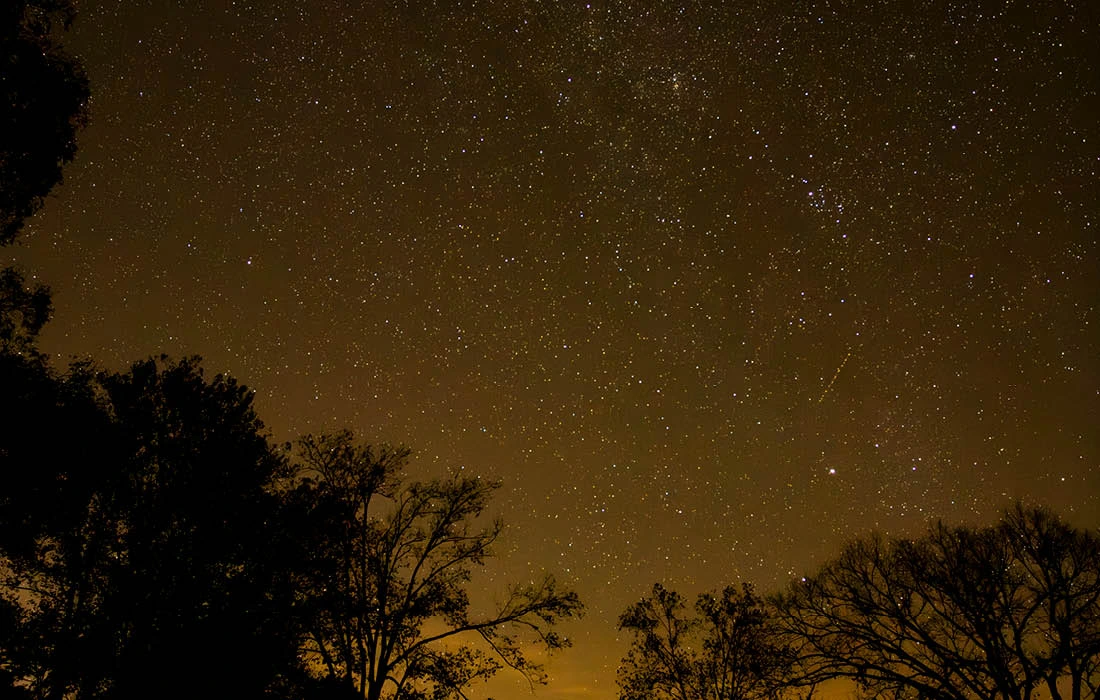
Astrotourism in the Ozarks
Nighttime satellite images of the United States reveal plenty of dark space in the west while the eastern half is lit up like a Christmas tree. It’s easy to see why Western states attract night sky viewing and photography.
And the Midwest? It’s a mixed bag, with bright pockets of light pollution surrounded by remote areas with truly dark skies. That makes the Ozarks ripe for astrotourism, a budding national trend where travelers plan trips around their desire to stargaze in areas without light pollution. It’s already happening in the Ozarks, say local astronomers and dark sky advocates, thanks in part to the Buffalo National River achieving Dark Sky Place status in 2019.
“The park is an icon,” says ANSA’s McMath. “It’s the crown jewel of Arkansas’ natural heritage resources,” he says. “That it got designated was a big eye-opener for people.” Now, McMath says, state parks, including Mt. Magazine, are adopting lightscape management, perhaps eventually leading to Dark Sky Place status, too.
On the Missouri side, there are plenty of truly dark locations for stargazing around the Current and Jacks Fork rivers, says Dena Matteson, Chief of Interpretation, Planning and Partnerships with the Ozark National Scenic Riverways. “We’re fortunate to have a lot of land around us that isn’t in development, and probably won’t ever be, hopefully,” she says. “So we can at least hold this little oasis down here for the future.”
Ozark National Scenic Riverways works with DarkSky Missouri to host its festival, and Matteson says there’s strong interest in the federal park to apply for Dark Sky Place status like the Buffalo did. But it will take a while to get there, she says: “We’re still working through some of the process.”
Still, Missouri is making progress. A collaborative effort between DarkSky Missouri, Missouri State Parks, the city of Kirksville and Truman University paid off when Thousand Hills State Park earned its Urban Night Sky Place designation in late 2024. Ideally, as communities grow and expand, they will make smart decisions to reduce light pollution and protect the Ozarks’ dark skies. Otherwise, those skies and their stars will diminish, Matteson says: “And you don’t know what you’ve got until it’s gone.”
Astronomical Events
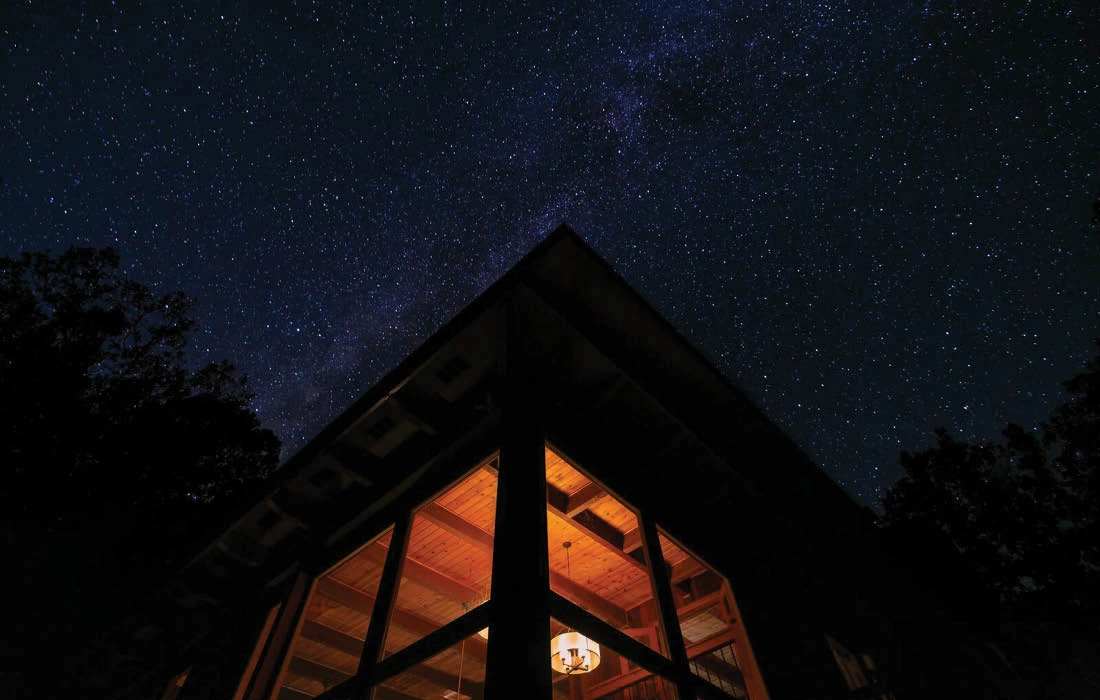

Springfield Astronomical Society Meetings
When: 7 p.m. Aug. 26, Sept. 23, Oct. 28, Nov. 25
Where: Library Center, 4653 S. Campbell Ave.
About: The SAS meets every fourth Tuesday of the month, except December. Meetings, open to the public, feature presentations and discussions of celestial occurrences, including the constellation of the month. Learn more at the Springfield Astronomical Society website or Facebook group. In addition, SAS will partner with several local organizations for outreach night sky events in September and October.
Baker Observatory Public Viewing Events
When: September, October, November 2025 (dates to be determined)
Where: Baker Observatory, 1766 Old Hillcrest Road, Fair Grove
Distance: 40 minutes northeast of Springfield
About: Missouri State University’s Physics, Astronomy and Materials Science Department presents free night sky viewing events using outdoor telescopes in addition to the 20-inch and 12-inch telescopes inside the observatory.
Arkansas Dark Sky Festival
When: Sept. 19-20 (rain dates Sept. 26-27)
Where: Bear Creek Log Cabins property, 6403 N. Highway 65, St. Joe, Arkansas
Distance: 2 hours southeast
About: Presented by the Arkansas Natural Sky Association (ANSA) and numerous partnering organizations, the festival features daytime presentations, organized hikes, and educational activities for kids and adults, including nighttime photography, birding, solar observing, and stargazing activities with telescopes and constellation tours on Friday and Saturday nights. Learn more about the festival and overnight accommodations.
Missouri Dark Sky Festival
When: Oct. 17-18
Where: Big Spring Campground, off Missouri 103, Van Buren
Distance: 2 hours, 30 minutes east
About: Members of Dark Sky Missouri and partnering organizations present a roundup of daytime educational presentations, including night sky photography, how to use a telescope, how to incorporate responsible lighting, a nature hike and other activities Friday and Saturday. It concludes with a Saturday night Star Party, with telescope viewing and constellation tours by astronomy experts. Learn more about the festival and overnight accommodations.
Stargazing & S’mores
When: Fall
Where: Finley Farms, 802 Finley Farms Lane, Ozark
Distance: 25 minutes south
About: Finley Farms will host a fun, family-friendly stargazing night in collaboration with the Springfield Astronomical Society with telescopes. Treats including s’mores, hot chocolate, coffee and cider, or a food truck and The Ozark Mill restaurant, will be available for heartier fare. Visit the website or call 417-210-6644 to learn more.
Starry Sky Nights
When: 8:30 p.m. Aug. 23, 8 p.m. Sept. 20, 8 p.m. Oct. 18
Where: Onondaga Cave State Park, 7555 Missouri H, Leasburg
Distance: 2 hours, 20 minutes northeast
About: Astronomy experts lead stargazing programs about planets and stars using telescopes. Call 573-245-6576 or register online and find more state park astronomy events here.
Star Parties
When: 8:15-9:15 p.m. Aug. 23, 7:30-8:30 p.m. Sept. 19, 6:45-7:45 p.m. Oct. 25
Where: Withrow Springs State Park, 33424 Spur 23, Huntsville, Arkansas
Distance: 2 hours southwest
About: Park staff and the Northwest Arkansas Astronomical Society present night sky wonders using telescopes. Call 479-559-2593 or visit the Arkansas State Park website for more information and stargazing events at more distant Arkansas parks, including Mt. Magazine.
Milky Way Photography Workshops
When: Aug. 23 (beginner) and Sept. 13 (advanced)
Where: Upper Buffalo Wilderness Area
Distance: Roughly 2+ hours south
About: Photographer Brennen Nicole conducts beginner and advanced Milky Way Photography Workshops; fee: $279 / $299. Visit brennennicole.com to learn more.
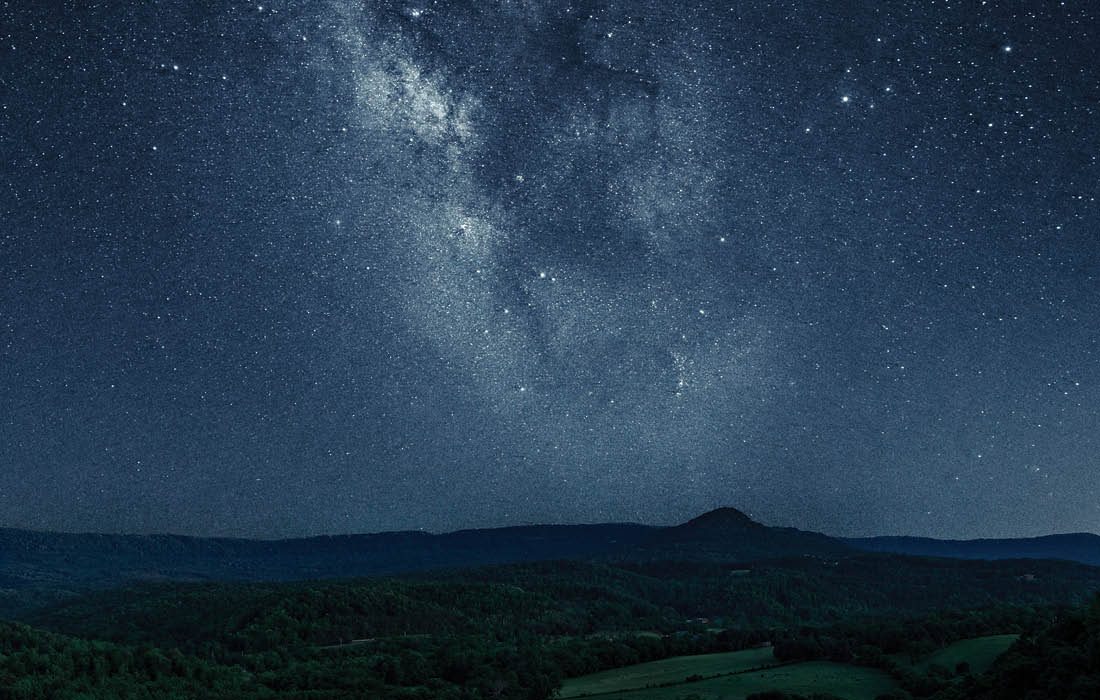
Date Night Stargazing
What’s more romantic than counting stars in a clear, dark sky? Book a remote cabin with a big view or a comfortable room in a cozy lodge where you can do that in peace, just minutes from your bed. Late summer into fall is the perfect time to look for the Milky Way without staying up too late. For the best star-gazing experience, book your getaway near a new moon night. Here are four places to try.
Ponca, Arkansas
Distance: 2 hours south of Springfield
Stay here: Buffalo Outdoor Center’s overlook cabins are good options for night sky viewing in the Buffalo National River area, which is a designated Dark Sky Park. Try Cabin X with a hot tub for a private, romantic overnight; or the Big Sky Cabin for a group outing. Both cabins have incredible views of the night sky.
While you’re there: Hike the Lost Valley Trail; watch for Boxley Valley elk at dawn or dusk; splash in a Buffalo River swimming hole at Steele Creek Campground; dine at the famous Ozark Cafe in Jasper.
Dora, Missouri
Distance: 2 hours southeast of Springfield
Stay here: The 350-acre River of Life Farm on the North Fork of the White River has a dozen two-person cabins with whirlpool tubs – including tree-house styles – for a romantic weekend of outdoor adventure. Cabins for groups and lodge rooms are also available. During your stay, walk to the property’s dedicated night sky observing area for stargazing.
While you’re there: Float the North Fork; cast for wild rainbow trout; book a massage; hike on the property or nearby trails; dine on homestyle cooking at the Falls Restaurant.
Echo Bluff State Park, Missouri
Distance: 2 hours, 20 minutes east of Springfield
Stay here: The Betty Lea Lodge with a wide back deck and comfortable modern rooms makes a beautiful home base for a cozy getaway in one of Missouri’s darkest state parks. Going with a group? Book a cabin. At night, stroll down to Echo Bluff to stargaze or drive up to the “sky porch” – the Bluff Top Pavilion – for night sky viewing.
While you’re there: Hike the Painter Ridge Trail; cool off in Sinking Creek at the massive Echo Bluff; book a Current River float; dine at the lodge’s Creekside Grill; visit nearby Alley Spring and its iconic red mill; stop for ice cream at the Dairy Shack in Eminence; fish for trout at Montauk State Park.
Mount Magazine State Park, Arkansas
Distance: 4 hours southwest of Springfield
Stay here: For a special extended weekend on Arkansas’ highest mountain, stay at the Lodge at Mount Magazine with breathtaking views of the Petit Jean River Valley. Book one of 60 lodge rooms or a cabin with one to three rooms. Mount Magazine is known for its broad vista views and dark night skies.
While you’re there: Hike the Signal Hill Trail to the highest point in Arkansas at 2,753 feet; ride the Huckleberry Mountain Trail; soak in views on the Cameron Bluff Overlook Drive; swim in the lodge’s indoor pool; dine at the Skycrest Restaurant.
Web Resources and Apps
Local astronomy experts recommended these apps and websites for finding dark skies and learning more about celestial objects.
Apps
Ephemeris
The Moon
Stellarium
Sky View Lite
Northern light aurora forecast
Sky Safari









